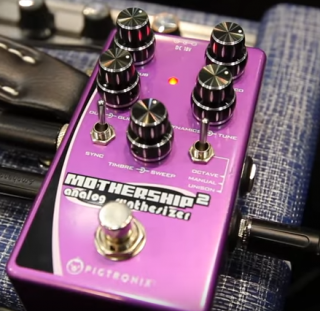Pedal maker Pigtronix is launching the second version of its Mothership analog synth pedal. Years in development, the Mothership 2 pedal is a velocity-sensitive, pitch-tracking, three-voice analog synthesizer with oscillator hard sync and pitch modulation via portamento and CV / expression control.
Housed in a compact aluminum chassis, the Mothership 2 pedal is a user-friendly guitar synth with real-time pitch and amplitude tracking, switchable preset tunings and a “devastating” Sync effect that delivers new modulation effects for guitar and bass.
The Sync effect found in the Mothership 2 can be dialled in to create an array of unique sounds using the Sweep and Timbre controls, as well the on-board Glide function to achieve modulation and pitch effects that sweep from one note to another with adjustable timing. An optional expression pedal / CV input can also be used to modulate the VCO in parallel with the on-board knobs and Glide function, creating “Sync Sweep” effects from another planet.
- Three analog oscillators: Triangle, Square, Sub-octave (Sine)
- World’s fastest pitch tracking circuit
- Velocity-sensitive dynamics control
- Glide control for pitch-following portamento
- Hard sync function w/ glide modulation
- TRS expression / TS CV input (0-5V range)
- sub-octave output removes sub-octave from main output
- 18VDC operation (300mA power supply included)
- True bypass
The dashboard of the Mothership 2 contains five, custom-made, dual-concentric potentiometers and a pair of toggle switches.
The top row of controls provides individual level knobs for VCO (Triangle wave) and Square-wave voices as well as the original Clean guitar sound and a Sub-octave Sine wave voice that can be removed from the main mix bus and sent to its own dedicated bass amplifier when the SUB output jack is used.
The middle row of controls provides Master Volume, Glide, Fine Tune and an adjustable Dynamics function that allows the player to adjust the “feel” of the synth’s amplitude tracking.
The bottom row of controls contains the three-way tuning switch with Unison, Octave Up, and Interval (Maj 3rd, 4th, 5th) presets as well as a new Sync function that slaves the VCO’s triangle and square wave oscillators to the input signal, creating a pitch-locked, unison sound with complex harmonics and overtones that can be modulated.
Pricing and Availability. The Mothership 2 will be available for $249 USD, starting in September 2017. More information is on the Mothership 2 official product page.



That’s a fun box. Tracks nicely and has a nice range of sounds.
I’d be curious how its tracking compares to doing a MIDI conversion (via something like MIDImorphosis) and running a digital synth. I expect that the latency would start to be noticeable in that scenario.
250 USD is a little pricey, but since the tones are relatively pleasant, it could be useful for more of a range of things, like adding octaves, covering an occasional bass line, or making blending in some added sweep to a lead.
dude has quite the guitarfaces going on.
Cool Idea but without MIDI/Presets, how would a guitarist get the most out of this live? If a pedal isn’t “set and leave it” like a compressor or doesn’t have presets/MIDI for different songs/foot controls, then you are constantly bending over and taking your hands off your instrument I.E. not playing music.
Probably fun for the studio I guess but there is far cheaper software to achieve pitch tracking and then send it to soft synths and external gear.
I love pigtronix pedals but sorry, this seems like a pedal that would start collecting dust after the novelty wears off.
The same applies to every other pedal that is marketed as “flexible” but doesn’t have patch memory.
Flexible pedals should have a separated remote footswitch in order to control the knobs more close to your hands without having to bend down. Now, is that useful for someone with his/her hands busy playing? I think yes but YMMV
Ten knobs (5 concentric pairs), and two switches. That’s not exactly a sprawling UI. IF a person wanted to use this for live, they could just have a little cheat sheet of a few settings– for whatever things it is used for, yes, not ideal, but not entirely unreasonable.
I think if it is used with care & “musicality”, it could be more than a “novelty”. This does give you some ability to bend notes, vibrato, etc. But it doesn’t let you deal with polyphony.
As I mentioned above, it would be useful to know how the tracking & latency would compare to a MIDI converter with a digital synth app. One option is to take the audio signal from the guitar and derive MIDI from there. I’m not familiar with these devices, but I recall seeing some device that took individual audio streams from each string to generate polyphonic MIDI data. Not sure what’s out there right now.